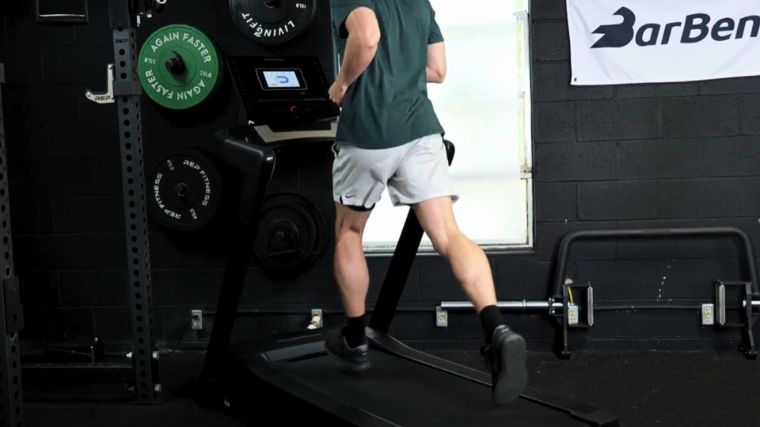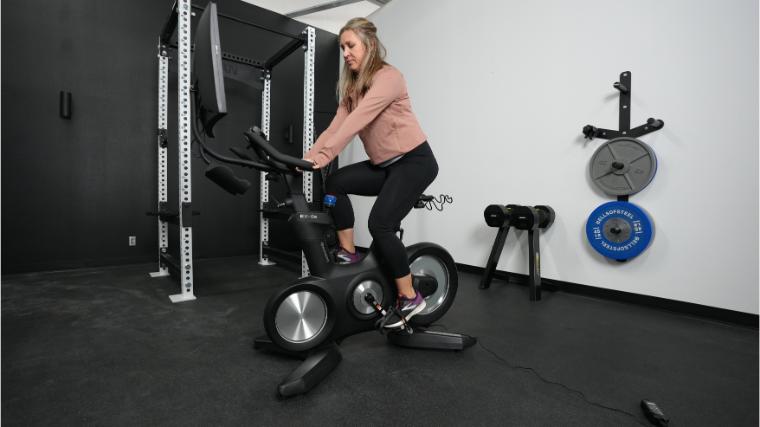You’re just completing your latest round of treadmill running, and you’re feeling a satisfying burn in your legs — from your glutes, quads, and hamstrings, all the way down to your calves. Then comes a fire-like ache in your shins (the fronts of your lower legs). Every time your foot comes down, that pain pops up. It may or may not subside after your workout, or even after all of the other muscle fatigue fades away. That’s when the personal trainer at your gym suggests that you might have a case of shin splints.
Perhaps you associate shin splints with the runners on your high school’s track team who sat in the bleachers during practices with bags of ice on their legs. You’ve been making such great progress with your training, and the last thing you want is to be forced into taking time off. So what are shin splints, how did you get them from a treadmill, and how do you prevent shin splints from a treadmill in the first place?
What Are Shin Splints?
“Shin splints” is the layman’s term for Medial Tibial Stress Syndrome (MTSS), which is exercise-induced pain in the tibialis anterior, more commonly known as the anterior (front) shin. Some people think shin splints refer to literal damage to the tibia, resulting in a case where the shin splints — but the reality is that it’s a tissue injury that can precede a more serious bone injury. (1)
[Read More: The Anatomy of Your Leg Muscles, Explained (and How to Train Them)]
“MTSS is classified as an overuse type injury, where the distal tibia experiences repeated and traumatic loading, causing microdamage to the cortical bone,” explains Asti. “The connective tissue layer over the bone becomes inflamed from traction forces of the lower leg muscles. Over time, if not given adequate rest for healing, the microdamage can progress to stress fractures.”
Why You Get Shin Splints on the Treadmill
One of the common causes of shin splints is repeated foot strikes against hard surfaces, which causes soreness in your shins, also known as your tibias. With that being the case, you might think that the additional cushioning provided by the softer treadmill surface would keep you protected. However, the mechanics of a treadmill running can actually worsen shin splints.

[Read More: The Best Treadmills for Walking, Researched and Tested by Our Team]
“The reason that treadmills are likely to cause shin splints is due to the movement of the belt under the feet,” says Asti. “Unlike running on a sidewalk or trail, the belt of the treadmill pulls our heel backward as we heel strike. This action causes the muscles of our hips, knees, and lower legs to fire in a slightly different pattern. It’s a pattern that mimics how our body controls downhill running. This places increased stress on the tibia and lower leg, which can cause shin splints.”
How to Prevent Shin Splints From a Treadmill
Don’t despair — it’s not a foregone conclusion that you’re going to get shin splints from treadmill running. There are several steps (pun intended) that you can take to ensure that you remain free from shin splint pain.
Take it Slow
Whether you’re a beginner or an expert runner, you may go through periods of rapid improvement that leave you wanting to quickly increase your running volume. Even if the rest of your body can endure that increase, there’s a good chance that the muscles surrounding your shin bones cannot. So be careful to avoid the sort of fast volume increase that can result in shin splints.
[Read More: 10 Science-Backed Benefits of Walking for Strength Athletes]
“Just like avoiding shin splints with road and trail running, the first step you should take to prevent yourself from getting shin splints is to slowly and gradually increase the load and volume of running,” says Asti. “Don’t make sudden increases in training volume so that your muscles can gradually adapt to the added stress.” For our lifters out there, think of it as progressive overload (only changing one training variable at a time), but for running.
Get the Proper Paraphernalia
Items like insoles, inserts, and arch supports are orthotic devices that are often mischaracterized only as tools that assist older populations. Athletes of all ages require different orthotic aids that are tailored to their running form and help them avoid running injuries like shin splints. (2) This also extends to getting the right running shoes to accommodate your foot strike, especially if you have pronated feet. (3)
[Read More: The Best Stair Climbers for Budget, Small Spaces, And More]
“Addressing any biomechanical factors that may predispose you to shin splints will help reduce your risk,” says Asti. “Proper running shoes for your foot type are a must in shin splint prevention. You’ll also need orthotics if you have flat feet or an overpronation of your feet.”
Prehab Strength Training
Another way to avoid shin splints and keep your treadmill training pain-free is to preemptively prepare your muscles for the rigors of exercise. This can include beginning your sessions with a thorough warm-up, cross-training with biking to give your shins a break from the impact, and also strengthening your lower leg muscles.

[Read More: Best Ellipticals]
“You can reduce your likelihood of developing shin splints by improving your hip external rotation range of motion and making sure your calf muscles are strong and flexible,” advises Asti. “Eccentric calf training is the best method in this case. It will also loosen your Achilles tendons, which can prevent many of the circumstances that cause shin splints to occur.”
Minimize the Effect of the Belt
If your shin splints are caused by agitation provided by the treadmill belt, the simple truth is that the belt isn’t going anywhere — you’re going to have to learn to conform to its presence. Fortunately, there are ways to minimize a treadmill’s potential impacts on your shins.
[Read More: At-Home Workouts for Strength, Muscle Growth, Power, and More]
“Remember, the treadmill is directing your leg muscles into a movement pattern that more closely resembles how they act during downhill running,” says Asti. “By adding two to four degrees of incline on the treadmill, that can be enough to negate the effect of the belts.”
How to Treat Shin Splints From the Treadmill
Once you’ve been diagnosed with an official case of shin splints, the protocol for treating the injury is typically the same regardless of how it occurred.
The good news is that there is a tried and true method for healing shin splints, but be forewarned: The consequences of not following a recovery plan can be severe. In short, you can end up with a problem far worse than shin splints.
Rest Your Legs
As much as you may pride yourself on your resilience and your desire to work through discomfort, your mental toughness can work against you when it comes to shin splints. This is because shin splints are an overuse injury to begin with, so continuing to push through the pain is likely to exacerbate whatever pain and injuries are already present.
[Read More: Best Rowing Machines]
“The first step in healing for any overuse injury is rest,” says Asti. “Specifically, in this case, you need to rest from running and any other repetitive loading-type activities. Depending on the individual and the severity of shin splint symptoms, the rest period can last anywhere from two to six weeks.”
Treat the Inflammation
Even after you’ve discontinued running, the inflammation and pain that typify shin splints are likely to persist. In this case, you’ll need to change the way you approach training, in addition to directly treating the pain and the underlying inflammation.
[Read More: The Best Foods and Supplements for Fighting Inflammation]
“Treating the inflammation and pain with non-steroidal anti-inflammatory drugs (NSAIDS) such as ibuprofen can be done in the early phases of addressing shin splint discomfort,” says Asti. “But these measures should always be applied in conjunction with the steps you take to address biomechanical factors, like improving calf-muscle flexibility and eccentric strength, and correcting the position of your feet.”
Return to Running Slowly
Eventually, your body should heal from shin splints to the point where you’ll be prepared to make a triumphant return to treadmill training. Well, now is the time to show great restraint, and very slowly increase your training output. Otherwise, you may find yourself sidelined with bags of ice over your shins once again.
“Returning to running should be done very gradually, with a significant reduction in volume,” says Asti. “If the pain resumes with activity, it would be wise to consider physical therapy or a running gait assessment to correct any additional factors that could be causing the pain.”
Your Takeaways
- Shin splints are an overuse injury that affects the muscles and connective tissues around your anterior shins.
- Treadmill running causes shin splints because the belt position places more stress on your tibialis anterior.
- Shin splints from treadmill training can be avoided by slowly increasing training volume and intensity, and engaging in strength training for the muscles around the shins.
- Wearing orthotic devices that improve foot posture and slightly inclining the treadmill can also reduce your likelihood of a shin splint diagnosis.
- Shin splints should be treated by discontinuing your treadmill training and addressing the pain and discomfort of the injury, which can take two to six weeks.
- Return to treadmill training only once your symptoms have completely disappeared, and increase volume and intensity very slowly.
FAQs
The answers below will help you to prevent yourself from ever being sidelined by a serious case of shin splints.
Why do I get shin splints from the treadmill?
You get shin splints from the treadmill because the belt of the treadmill pulls the muscles of your legs beneath you and into an atypical alignment. This alignment closely resembles the muscle configuration of downhill running, which is a position in which greater stress is placed on your shins.
Is it OK to run with shin splints?
It is not advised that you run with shin splints. Asti says that running with shin splints will not only worsen the pain but can lead to chronic shin splints and ultimately tibial stress fractures. “If you feel like you have to run, try running on alternate surfaces that are softer such as crushed limestone trails, tracks, or even in the pool,” advises Asti.
How can I prevent shin splints on a treadmill?
Asti advises that you prevent shin splints on a treadmill by inclining the treadmill two to four degrees. In addition, she suggests that you increase the volume of your training very slowly so that your shins can adapt to the increased workload. She also recommends the use of orthotics to correct foot posture and lower-body strength training to prepare your body to endure the impact from running.
Editor’s Note: The content on BarBend is meant to be informative in nature, but it should not be taken as medical advice. When starting a new training regimen and/or diet, it is always a good idea to consult with a trusted medical professional. We are not a medical resource. The opinions and articles on this site are not intended for use as diagnosis, prevention, and/or treatment of health problems. They are not substitutes for consulting a qualified medical professional.
References
- McClure CJ, Oh R. Medial Tibial Stress Syndrome. [Updated 2023 Aug 8]. In: StatPearls [Internet]. Treasure Island (FL): StatPearls Publishing; 2024 Jan-.
- Bonanno DR, Murley GS, Munteanu SE, Landorf KB, Menz HB. Effectiveness of foot orthoses for the prevention of lower limb overuse injuries in naval recruits: a randomised controlled trial. Br J Sports Med. 2018 Mar;52(5):298-302. Yates B, White S. The incidence and risk factors in the development of medial tibial stress syndrome among naval recruits. Am J Sports Med. 2004 Apr-May;32(3):772-80.